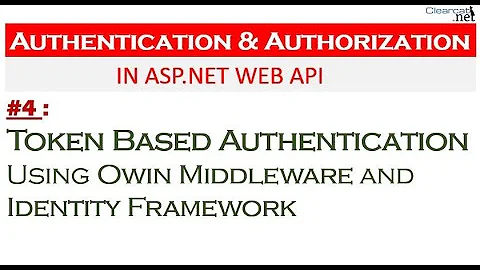How to get authorization code with OWIN, OAuth and Web API?
A crucial thing to remember when using the OAuth2 authorization server built in Katana is that its authorization endpoint is pass-through by default: you must provide your own /authorize endpoint (using MVC or Nancy for instance) or directly render your consent form in OAuthAuthorizationServerProvider.AuthorizationEndpoint.
You can take a look at the official documentation for a complete walkthrough indicating how you can implement your own MVC controller and your own authorization endpoint.
Related videos on Youtube
DotNetMatt
Updated on June 04, 2022Comments
-
DotNetMatt almost 2 years
I followed this post: Token Based Authentication using ASP.NET Web API 2, Owin, and Identity. Now, I have a Web API standalone "server" able to successfully authenticate users and returns an Access Token when I send username/password to it. Then, I can use the Access Token to access protected data (in the blog post, I can access the Orders).
For now, the client from which I sent username/password to get the Access Token is a Console app.
I want to add a bit more complexity and before getting the Access Token, I would like to get an Authorization Code. But I cannot find any example on how to do it. From what I read, I should send a GET request structured like this:
/authorize?response_type=code&client_id=< ClientID>
This is what I am doing from my console app:
using (var client = new HttpClient()) { var response = await client.GetAsync("http://localhost:63828/authorize?response_type=code&client_id=" + Guid.NewGuid()); var responseString = response.Content.ReadAsStringAsync().Result; }But I get an error message:
The resource cannot be found.
[HttpException]: The controller for path '/authorize' was not found or does not implement IController. at System.Web.Mvc.DefaultControllerFactory.GetControllerInstance(RequestContext requestContext, Type controllerType) at System.Web.Mvc.DefaultControllerFactory.CreateController(RequestContext requestContext, String controllerName) at System.Web.Mvc.MvcHandler.ProcessRequestInit(HttpContextBase httpContext, IController& controller, IControllerFactory& factory) at System.Web.Mvc.MvcHandler.BeginProcessRequest(HttpContextBase httpContext, AsyncCallback callback, Object state) at System.Web.Mvc.MvcHandler.BeginProcessRequest(HttpContext httpContext, AsyncCallback callback, Object state) at System.Web.Mvc.MvcHandler.System.Web.IHttpAsyncHandler.BeginProcessRequest(HttpContext context, AsyncCallback cb, Object extraData) at System.Web.HttpApplication.CallHandlerExecutionStep.System.Web.HttpApplication.IExecutionStep.Execute() at System.Web.HttpApplication.ExecuteStep(IExecutionStep step, Boolean& completedSynchronously)
This is the content of the Startup.cs file in the Web API project:
public class Startup { public void Configuration(IAppBuilder app) { HttpConfiguration config = new HttpConfiguration(); ConfigureOAuth(app); WebApiConfig.Register(config); app.UseCors(Microsoft.Owin.Cors.CorsOptions.AllowAll); app.UseWebApi(config); } public void ConfigureOAuth(IAppBuilder app) { OAuthAuthorizationServerOptions OAuthServerOptions = new OAuthAuthorizationServerOptions() { AllowInsecureHttp = true, TokenEndpointPath = new PathString("/token"), AuthorizeEndpointPath = new PathString("/authorize"), ApplicationCanDisplayErrors = true, AccessTokenExpireTimeSpan = TimeSpan.FromDays(1), Provider = new SimpleAuthorizationServerProvider() }; // Token Generation app.UseOAuthAuthorizationServer(OAuthServerOptions); app.UseOAuthBearerAuthentication(new OAuthBearerAuthenticationOptions()); } }What I find weird is that I defined the "/authorize" endpoint but it is not accessible... The "/token" endpoint is accessible and I did not do anything special for this.
Any idea how I can overcome this?
-
 foyss over 4 yearsDid you ever manage to get the authorization code from your authorization endpoint? If so, how?
foyss over 4 yearsDid you ever manage to get the authorization code from your authorization endpoint? If so, how?
-
-
 Kévin Chalet over 8 yearsFor a complete sample, you can also take a look at this Nancy client/server demo. It doesn't use
Kévin Chalet over 8 yearsFor a complete sample, you can also take a look at this Nancy client/server demo. It doesn't useOAuthAuthorizationServerMiddlewarebut a much more elaborated fork targeting OpenID Connect but you should get the idea.






